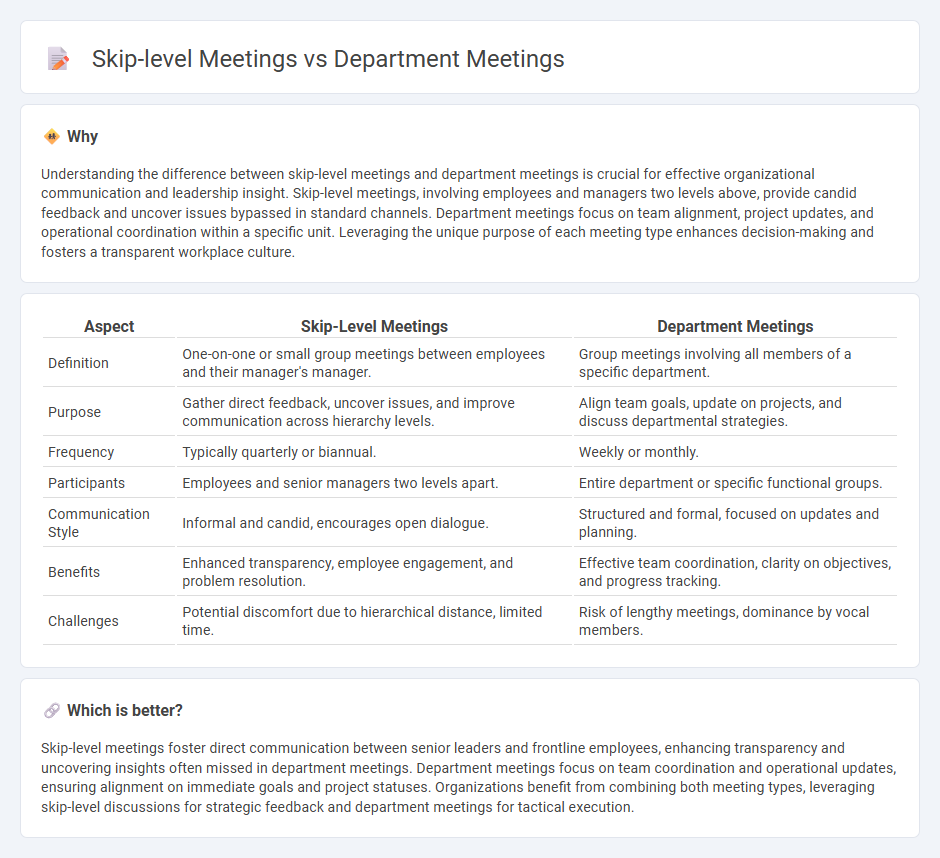
Skip-level meetings facilitate direct communication between upper management and employees two or more levels below, fostering transparency and uncovering insights often missed in traditional hierarchies. Department meetings focus on aligning team objectives, discussing project progress, and resolving operational issues within a specific unit to enhance efficiency and collaboration. Explore effective strategies for conducting both meeting types to optimize organizational communication and decision-making.
Why it is important
Understanding the difference between skip-level meetings and department meetings is crucial for effective organizational communication and leadership insight. Skip-level meetings, involving employees and managers two levels above, provide candid feedback and uncover issues bypassed in standard channels. Department meetings focus on team alignment, project updates, and operational coordination within a specific unit. Leveraging the unique purpose of each meeting type enhances decision-making and fosters a transparent workplace culture.
Comparison Table
| Aspect | Skip-Level Meetings | Department Meetings |
|---|---|---|
| Definition | One-on-one or small group meetings between employees and their manager's manager. | Group meetings involving all members of a specific department. |
| Purpose | Gather direct feedback, uncover issues, and improve communication across hierarchy levels. | Align team goals, update on projects, and discuss departmental strategies. |
| Frequency | Typically quarterly or biannual. | Weekly or monthly. |
| Participants | Employees and senior managers two levels apart. | Entire department or specific functional groups. |
| Communication Style | Informal and candid, encourages open dialogue. | Structured and formal, focused on updates and planning. |
| Benefits | Enhanced transparency, employee engagement, and problem resolution. | Effective team coordination, clarity on objectives, and progress tracking. |
| Challenges | Potential discomfort due to hierarchical distance, limited time. | Risk of lengthy meetings, dominance by vocal members. |
Which is better?
Skip-level meetings foster direct communication between senior leaders and frontline employees, enhancing transparency and uncovering insights often missed in department meetings. Department meetings focus on team coordination and operational updates, ensuring alignment on immediate goals and project statuses. Organizations benefit from combining both meeting types, leveraging skip-level discussions for strategic feedback and department meetings for tactical execution.
Connection
Skip-level meetings provide senior managers with direct insights from employees two or more levels below, uncovering issues that might not surface in regular department meetings. Department meetings focus on operational updates and team alignment within a single managerial level, serving as a platform for immediate feedback and coordination. Combining skip-level and department meetings enhances communication flow, allowing strategic priorities set by senior leaders to be effectively translated into actionable tasks at the team level.
Key Terms
**Department meetings:**
Department meetings facilitate direct communication among team members, enabling collaboration on projects, alignment on goals, and efficient problem-solving within the department. These meetings often include updates on progress, resource allocation, and strategic planning tailored to specific departmental needs, enhancing overall productivity. Explore more to understand how structured department meetings can drive your team's success.
Agenda
Department meetings typically concentrate on team progress, project updates, and operational challenges to ensure alignment and address immediate concerns within the group. Skip-level meetings prioritize strategic discussions, employee feedback, and broader organizational insights by facilitating direct communication between employees and higher-level management, bypassing direct supervisors. Explore how tailoring agendas for these meeting types can enhance communication and organizational efficiency.
Collaboration
Department meetings foster collaboration by bringing team members together to discuss projects, share updates, and align goals, promoting teamwork and collective problem-solving. Skip-level meetings enhance collaboration between employees and higher-level managers, bypassing direct supervisors to encourage open communication, feedback, and strategic alignment. Discover how integrating both meeting types can optimize collaboration and drive organizational success.
Source and External Links
Department Meeting : Everything You Need to Know - Department meetings are regular gatherings where team members align on goals, share updates, discuss current issues, assign tasks, and plan next steps through a structured agenda including introductions, updates, discussions, and training opportunities.
9 Tips for Effective Departmental Meetings to Boost Productivity - Effective departmental meetings focus on clear purpose and agenda, involve the right participants, and cover topics such as ongoing projects, goals, challenges, and deadlines to facilitate collaboration and alignment.
Department Meetings - Office of the Provost - Departments should meet regularly at scheduled times to discuss responsibilities, staffing, budget, assessment, curricular development, faculty scholarship, and other key issues with equitable delegation of duties recommended.
 dowidth.com
dowidth.com